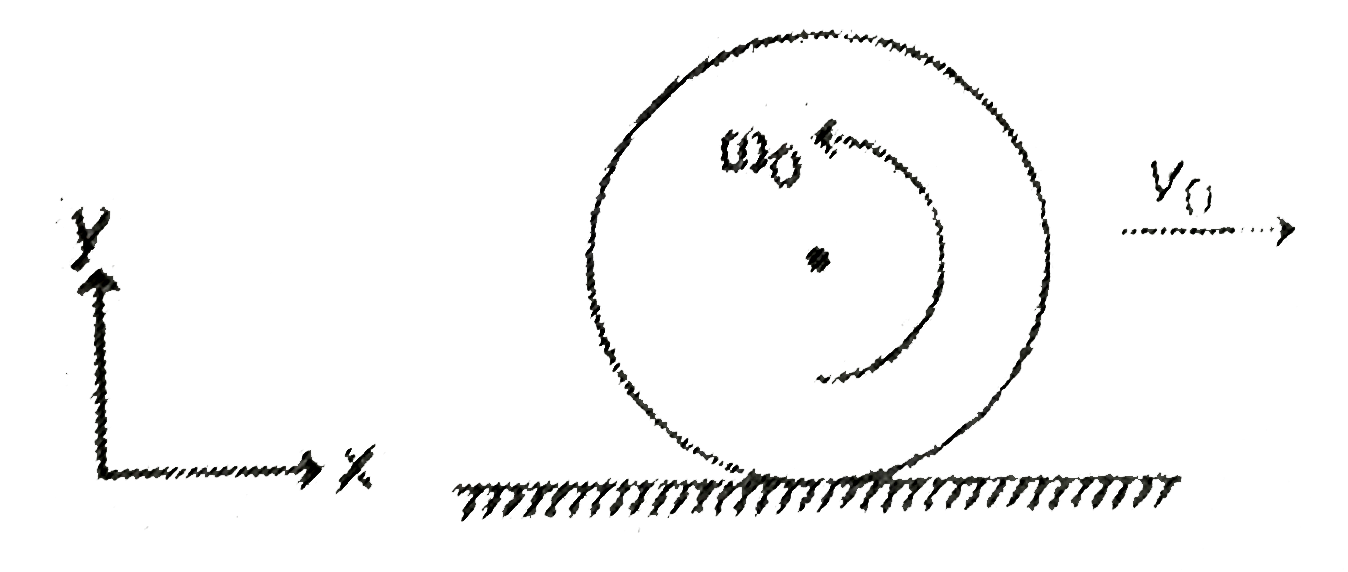We have a disc of neglligible thickness and whose surface mass density varies as radial distance from centre as σ=σ0(1+rR), where R is the radius of the disc. Specific heat of the material of the disc isC.
Disc is given an angular velocity ω0 and placed on a horizontal rough surface such that the plane of the disc is parallel to the surface. Coefficient of friction between disc and suface is μ. The temperature of the disc is T0.
Answer the following question on the base of information provided in the above paragraph
If the kinetic energy lost due to the friction between disc and surface is absorbed by the disc the moment heat is generated, by the mass lying at the point where the energy is lost. Assume that there is no radial heat flow in betwen disc particles. Rate of change in temperature at a point lying at r distance away from centre with time, before disc stops rotating, will be (α-magnitude of angular acceleration of rod)
μgrC(ω0−αt)
μgr2C(ω0−αt)
μgr3C(ω0−αt)
μgr4C(ω0−αt)
The correct Answer is:A
To solve the problem, we need to find the rate of change of temperature dTdt at a point lying at a distance r from the center of the disc before it stops rotating. We will follow these steps:
Step 1: Determine the Force of Friction
The force of friction F acting on the disc can be expressed as:
F=μ⋅N
where N is the normal force. For a disc lying on a horizontal surface, the normal force is equal to the weight of the disc. The weight can be calculated by integrating the mass density over the area of the disc.
Step 2: Calculate the Mass Element dm
The mass element dm at a distance r from the center can be expressed as:
dm=σ⋅dA=σ⋅2πrdr
where dA is the differential area element. Given that σ=σ0(1+rR), we can substitute this into the equation.
Step 3: Calculate the Work Done by Friction
The work done dW by the friction force during a small displacement ds is given by:
dW=F⋅ds=μ⋅N⋅ds
The displacement ds can be expressed as ds=r⋅dθ, where dθ is the angular displacement.
Step 4: Relate Work Done to Change in Temperature
The energy lost due to friction is absorbed as heat by the mass dm. The relationship between the heat absorbed dQ and the change in temperature dT is given by:
dQ=C⋅dm⋅dT
where C is the specific heat capacity of the material.
Step 5: Set Up the Equation
Equating the work done to the heat absorbed, we have:
μ⋅N⋅ds=C⋅dm⋅dT
Step 6: Substitute Expressions
Substituting the expressions for N, dm, and ds into the equation, we can solve for dTdt.
Step 7: Use Angular Velocity Relation
The angular velocity ω changes with time due to angular acceleration α:
ω=ω0−αt
Substituting this into our equation will give us the final expression for dTdt.
Final Expression
After substituting and simplifying, we arrive at:
dTdt=μgr(ω0−αt)C
The force of friction F acting on the disc can be expressed as:
F=μ⋅N
where N is the normal force. For a disc lying on a horizontal surface, the normal force is equal to the weight of the disc. The weight can be calculated by integrating the mass density over the area of the disc.
The mass element dm at a distance r from the center can be expressed as:
dm=σ⋅dA=σ⋅2πrdr
where dA is the differential area element. Given that σ=σ0(1+rR), we can substitute this into the equation.
The work done dW by the friction force during a small displacement ds is given by:
dW=F⋅ds=μ⋅N⋅ds
The displacement ds can be expressed as ds=r⋅dθ, where dθ is the angular displacement.
The energy lost due to friction is absorbed as heat by the mass dm. The relationship between the heat absorbed dQ and the change in temperature dT is given by:
dQ=C⋅dm⋅dT
where C is the specific heat capacity of the material.
Equating the work done to the heat absorbed, we have:
μ⋅N⋅ds=C⋅dm⋅dT
Substituting the expressions for N, dm, and ds into the equation, we can solve for dTdt.
The angular velocity ω changes with time due to angular acceleration α:
ω=ω0−αt
Substituting this into our equation will give us the final expression for dTdt.
After substituting and simplifying, we arrive at:
dTdt=μgr(ω0−αt)C
Similar Questions
We have a disc of neglligible thickness and whose surface mass density varies as radial disance from centre as σ=σ0(1+rR), where R is the radius of the disc. Specific heat of the material of the disc isC.
Disc is given an angular velocity ω0 and placed on a horizontal rough surface such that the plane of the disc is parallel to the surface. Coefficient of friction between disc and suface is μ. The temperature of the disc is T0.
Answer the following question on the base of information provided in the above paragraph
Magnitude of angular acceleration of disc isView SolutionA disc is given an initial angular velocity ω0 and placed on a rough horizontal surface as shown Fig. The quantities which will not depend on the coefficient of friction is/are
 View Solution
View SolutionA uniform disc of mass m and radius R is rotated about an axis passing through its center and perpendicular to its plane with an angular velocity ω. It is placed on a rough horizontal plane with the axis of the disc keeping vertical. Coefficient of friction between the disc and the surface is μ, find
(a). The time when disc stops rotating
(b). The angle rotated by the disc before stopping.View SolutionA uniform disc of radius R is spinned to the angular velocity ω and then carefully placed on a horizontal surface. How long will the disc be rotating on the surface if the friction coeffiecient is equal to k? The pressure exerted by the disc on the surface can be regarded as uniform.
View SolutionThe surface mass density of a disc of radius a varies with radial distance as σ=A+Br where A & B are positive constants then moment of inertia of the disc about an axis passing through its centre and perpendicular to the plane
View SolutionA disc of mass m and radius R rotating with angular speed ω0 is placed on a rough surface (co-officient of friction =μ). Then
 View Solution
View SolutionA disc is given an angular velocity ω0 and a linear velocity v0 as shown in the figure. It is released on a rough horizontal surface of friction coefficient μ. Mark the correct statement (ω0=3v0/R)
 View Solution
View SolutionA uniform disc is released from the top of a rough inclined plane of angle θ and height h. The coefficient of friction between the disc and the plane is μ=tanθ4. The speed of centre of mass of disc on reaching the bottom of the plane is
View SolutionA disc of radius R rotates with constant angular velocity ω about its own axis. Surface charge density of this disc varies as σ=αr2, where r is the distance from the centre of disc. Determine the magnetic field intensity at the centre of disc.
View SolutionFor a disc of given density and thickness, its moment of inertia varies with radius of the disc as :
View Solution

